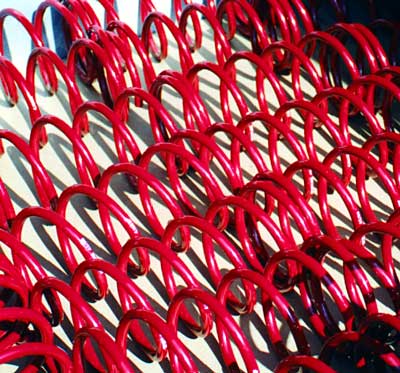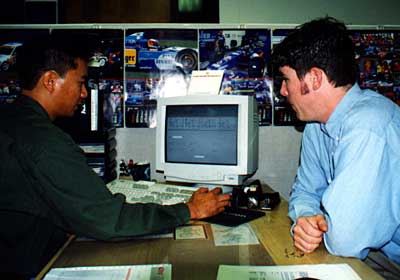INSIDE
RACING
T E C H N O L O G Y
Eibach, page 1
Eibach, page 1
Eibach, page 2
IRT Home
News Page
Contents Page
Newsletter &
Books
email Paul
Eibach Springs, Page 3

All springs are peened with steel shot which increases fatigue
strength by about 40%. The machine above grinds the coil ends
flat and perpendicular to the spring center line according to
DIN class 1 quality specifications. This translates to less than
0.050 in. (1.2mm) across a typical CART or IRL spring that is
2 in. in diameter and 4 or 5 inches long.
Finally each spring is pre-set. By design the winder produces
a spring with excess free length. During pre-set the spring is
compressed to block (coil bind) to stress relieve the spring
and set it to the final free length. After this process the spring
is block resistant, meaning that it can now safely travel to
coil bind and back to the design free length with no loss of
that free length.

As a check on the manufacturing process 10% of the springs go through a final inspection also using DIN class 1 specifications.

Each spring is phosphate sprayed and powder coated for corrosion
resistance and the spring rate is printed or tagged on each coil.
The result is a brightly-colored, precision spring.
Progressive Springs
Eibach designs and manufactures both linear and progressive springs
and progressive spring systems. Progressive systems use two or
more linear springs of different spring rates called main and
tender springs. The tender springs have a lower spring rate than
the main spring and are made from a special wire with a trapezoidal
cross section. After winding, the coils of the tender springs
can collapse flat against each other providing a stable platform
for the main spring to bear against.
Off-road racing vehicles use this type of suspension for soft
spring rates rising to higher rates as suspension travel increases.
Race cars with aerodynamic downforce can utilize the main spring
to support the car at speed and the tender spring in slow corners.
Formula Ford suspension tuners install small tender springs in
the rear suspension to prevent lifting the inside rear tire in
slow corners.
The barrel-shaped spring seen snaking out of the winding machine
on Page 2 is a clever device. A look back at the helical-coil
spring-rate equation on Page 1 reminds us a coil with a larger
diameter has a lower spring rate. The middle of the barrel-shaped
spring deflects more than the stiffer ends. This design allows
the smaller coils to nestle inside the larger ones at full deflection
providing more suspension travel than a conventional spring.

Design Software
Stan Hortinela, shown on the left with Motorsports Manager,
Beau Kelly, is an engineer at Eibach Springs with the additional
title of program manager. He explains the Wizard software used
to design the multiple-spring systems, "We enter the spring
material and the input values. The program needs spring internal
diameter, static load, deflection before transition to the main
spring, initial and final spring rates, and the amount of suspension
travel from the static position in both the bump and rebound
directions. The software calculates suggested output values,
picks Eibach part numbers, and shows us a force vs. deflection
graph.
"We also have our own spring design software. We get the
input numbers from customer requirements and the software suggests
a solution, but the engineer has to look at the trade-offs and
make adjustments to optimize the product. We put a lot of emphasis
on the ends of the spring being parallel. We want the lightest,
most reliable spring system that meets the customer's needs.
Stocking all the many wire diameters helps a lot."
"There are no super secrets here," Hortinela continues.
"We specify the best materials and we've learned a lot from
experience. This is a family-owned business and there's a lot
of pride in the product. We tell people about our manufacturing
process because we're proud of it and it helps sell the customer."
Visit Eibach's web site at: http://www.eibach.com.